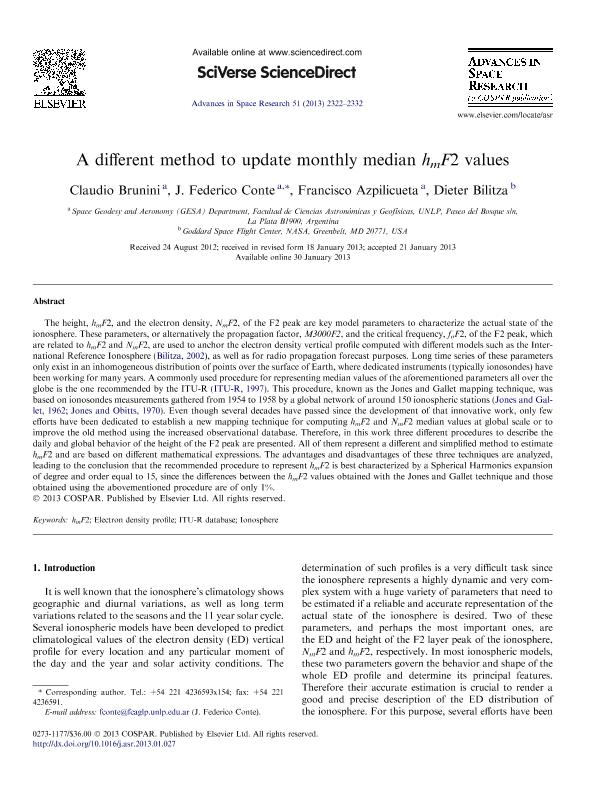Mostrar el registro sencillo del ítem
dc.contributor.author
Brunini, Claudio Antonio

dc.contributor.author
Conte, Juan Federico

dc.contributor.author
Azpilicueta, Francisco Javier

dc.contributor.author
Bilitza, Dieter
dc.date.available
2017-08-11T15:29:43Z
dc.date.issued
2013-01
dc.identifier.citation
Brunini, Claudio Antonio; Conte, Juan Federico; Azpilicueta, Francisco Javier; Bilitza, Dieter; A different method to update monthly median hmF2 values; Elsevier; Advances in Space Research; 51; 12; 1-2013; 2322-2332
dc.identifier.issn
0273-1177
dc.identifier.uri
http://hdl.handle.net/11336/22171
dc.description.abstract
The height, hmF2, and the electron density, NmF2, of the F2 peak are key model parameters to characterize the actual state of the ionosphere. These parameters, or alternatively the propagation factor, M3000F2, and the critical frequency, foF2, of the F2 peak, which are related to hmF2 and NmF2, are used to anchor the electron density vertical profile computed with different models such as the International Reference Ionosphere (Bilitza, 2002), as well as for radio propagation forecast purposes. Long time series of these parameters only exist in an inhomogeneous distribution of points over the surface of Earth, where dedicated instruments (typically ionosondes) have been working for many years. A commonly used procedure for representing median values of the aforementioned parameters all over the globe is the one recommended by the ITU-R (ITU-R, 1997). This procedure, known as the Jones and Gallet mapping technique, was based on ionosondes measurements gathered from 1954 to 1958 by a global network of around 150 ionospheric stations (Jones and Gallet, 1962; Jones and Obitts, 1970). Even though several decades have passed since the development of that innovative work, only few efforts have been dedicated to establish a new mapping technique for computing hmF2 and NmF2 median values at global scale or to improve the old method using the increased observational database. Therefore, in this work three different procedures to describe the daily and global behavior of the height of the F2 peak are presented. All of them represent a different and simplified method to estimate hmF2 and are based on different mathematical expressions. The advantages and disadvantages of these three techniques are analyzed, leading to the conclusion that the recommended procedure to represent hmF2 is best characterized by a Spherical Harmonics expansion of degree and order equal to 15, since the differences between the hmF2 values obtained with the Jones and Gallet technique and those obtained using the abovementioned procedure are of only 1%. 2013 COSPAR. Published by Elsevier Ltd. All rights reserved.
dc.format
application/pdf
dc.language.iso
eng
dc.publisher
Elsevier

dc.rights
info:eu-repo/semantics/openAccess
dc.rights.uri
https://creativecommons.org/licenses/by-nc-sa/2.5/ar/
dc.subject
Hmf2
dc.subject
Electron Density Profile
dc.subject
Itu-R Database
dc.subject
Ionosphere
dc.subject.classification
Oceanografía, Hidrología, Recursos Hídricos

dc.subject.classification
Ciencias de la Tierra y relacionadas con el Medio Ambiente

dc.subject.classification
CIENCIAS NATURALES Y EXACTAS

dc.title
A different method to update monthly median hmF2 values
dc.type
info:eu-repo/semantics/article
dc.type
info:ar-repo/semantics/artículo
dc.type
info:eu-repo/semantics/publishedVersion
dc.date.updated
2017-08-04T15:34:45Z
dc.journal.volume
51
dc.journal.number
12
dc.journal.pagination
2322-2332
dc.journal.pais
Países Bajos

dc.journal.ciudad
Ámsterdam
dc.description.fil
Fil: Brunini, Claudio Antonio. Consejo Nacional de Investigaciones Científicas y Técnicas; Argentina. Universidad Nacional de la Plata. Facultad de Ciencias Astronómicas y Geofísicas. Grupo de Geodesia Espacial y Aeronomia; Argentina
dc.description.fil
Fil: Conte, Juan Federico. Consejo Nacional de Investigaciones Científicas y Técnicas; Argentina. Universidad Nacional de la Plata. Facultad de Ciencias Astronómicas y Geofísicas. Grupo de Geodesia Espacial y Aeronomia; Argentina
dc.description.fil
Fil: Azpilicueta, Francisco Javier. Consejo Nacional de Investigaciones Científicas y Técnicas; Argentina. Universidad Nacional de la Plata. Facultad de Ciencias Astronómicas y Geofísicas. Grupo de Geodesia Espacial y Aeronomia; Argentina
dc.description.fil
Fil: Bilitza, Dieter. National Aeronautics and Space Administration; Estados Unidos
dc.journal.title
Advances in Space Research

dc.relation.alternativeid
info:eu-repo/semantics/altIdentifier/url/http://www.sciencedirect.com/science/article/pii/S0273117713000495
dc.relation.alternativeid
info:eu-repo/semantics/altIdentifier/doi/http://dx.doi.org/10.1016/j.asr.2013.01.027
Archivos asociados
